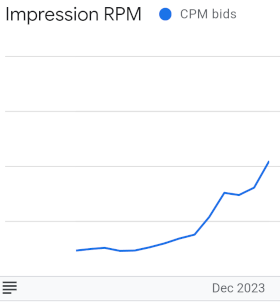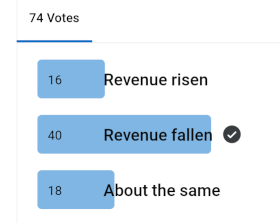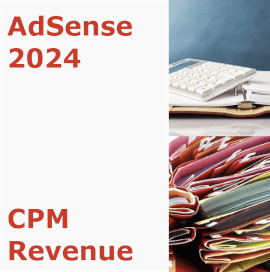AdSense Specials
CPM instead of CPC: the new revenue model and your optimisation strategy
The change is intended to improve comparability of offers, as many other advertisers charge on a CPM basis. However, there are still important questions surrounding the change.
What has happened so far
Google has announced in ablogpost that it will change the way it charges for impressions from the beginning of 2024. Impressions instead of clicks will be the determining factor. The new billing methodis more complicated, but the overall revenue for publishers should not change.
Previous billing was based on a small CPM share (about 5% for me) with a low impression RPM and a large share of CPC ads billed per click. Since 2.2.24, the CPM share is now almost 100% for most publishers. For the first few days it was 100% for me, but now almost every day a small percentage is also showing as CPC. This is an indication that the change is not yet complete.

The new basis of calculation remains a mystery, as Google is, unfortunately, mostly intransparent. Until now, the CPC has always been an important figure for many. It showed how much a click generated on average. This value and the number of clicks are still displayed, but it is only a calculated value that has no real meaning (any more).
Definitions
CPC: Revenue / number of clicks
CPM: Cost per Mille / cost per 1000 impressions
Impression RPM: Revenue per 1000 ads viewed
Page RPM: Revenue per 1000 pages viewed
The conversion raises the following questions:
- Will the previous low impression RPM now become the billing basis?
- As Google Ads will continue to offer advertisers cost-per-click billing: How will publishers be charged on a per-click basis in the future?
- How will the ratio of quality to quantity of ads affect revenue?
- What optimisation strategies will still be possible?
The new CPM value
Publishers with good click-through rates are concerned that the current very low CPM value will become the basis for billing in the future and that this will result in a significant loss of revenue.
How has the impression RPM of CPM ads changed since the changeover? I have been watching since the announcement. As Google had been testing the change before the announcement in November, and more intensively between November and February, you can see a trend: The value for my pages has quadrupled.

This means that the calculation basis has changed with the changeover.
The ads that are charged to the advertiser per click
In the first postI suggested that this is based on the auction value of the ads. The AdSense algorithm compares the CPM value of a CPM ad with the value of a click ad based on the likelihood that the ad will actually be clicked. The two types of ad are therefore compared in real time.
This is one possible explanation for the increase in impression RPM for CPM ads. As this method is described in the Google Ads help for the bidding process, I assume that it now applies here as well.
Update 1.3.24
The switch from clicks to CPM has been live for most AdSense accounts for 4 weeks now. Google had announced that the change should have no impact on revenues. Unfortunately, this has not been confirmed by many publishers. New considerations and tests are now necessary.
Initial impact of the move to CPM
My recommendation was to wait a month. I still think that my previous approach of tweaking mainly the'active view viewable' value will work here. In the event of losses, other approaches may be helpful.
The most important metric: Page RPM
Apart from absolute revenue, the most important metric has always been page RPM, i.e. how much I earn per 1000 page views. This metric used to be heavily influenced by the percentage of click-throughs. The aim of optimisation was to get as many valuable ads as possible and to present them in a way that generated clicks.
However, the second aspect should not be exaggerated, as invalid clicks, whether due to the type of placement or other factors, jeopardise the delivery of the ads or even the AdSense account. Therefore, my recommendation so far has been to focus on the first aspect. The 'visible with Active View Viewable' metric has played a big part in this.
The value of the ad is still important, but the click-through rate is no longer the main driver. My first suspicion: the quantity of ads is becoming more important to achieve a high page RPM. But even here there is a limitation: both usability for site users and the 'Better Ads' guidelines limit the increase in the number of ads.
The four weeks in progress
In the first week, my page RPM increased, but over the next 3 weeks, my page RPM continued to decrease, resulting in a drop of just over 20% for my pages.
Here is a graph comparing January and February:

A recentpoll on Redditconfirms that there seem to be more losers than winners from the change:

Update 9.5.24
I wanted to get back to you sooner, but a problem has made my testing unnecessary for the time being. But first things first.
The quantity test
One of my theses on the switch from CPC to CPM was:
„The quantity of ads is weighted more heavily“
So as a test, I increased the number of ads moderately. With the following results
- Ad load from 3.3 ads per page view to 4.2
- As expected, the impression RPM dropped by about 10%.
- Page RPM increased by approximately 15%.
- Active view visible fell from 71% to 61%.
The interim result after 14 days was initially positive and confirmed the thesis. However, the results were not yet statistically significant. Overall, even after this increase, the level was still well below the Page RPM level before the switch to CPM.
Invalid traffic or bug?
Then something happened that affected not only me but many other publishers. There is a detailed thread about this on the AdSense forum: AdSense Bug Invalid Traffic
The pages RPM value dropped to around 10%, a real disaster. In the thread, publishers have been reporting sudden drops in revenue at various times since mid-February. There was no statement from AdSense on the forum. Some have been able to get a statement from the support team: Invalid traffic.
As AdSense generally does not comment on thecauses of invalid trafficäußert, publishers have tried various things to fix the problem.
For me it started in the middle of March. I also received an 'invalid traffic' response from support, but could not find a cause. The only action I took was: I stopped the test and went back to the original number of ads.
My hope and assumption was that it was a bug. The algorithm had probably been revised and set to 'too sensitive'. The fact that so many publishers were suddenly affected at the same time suggested this. As invalid traffic is often tested for around 30 days, I generally kept calm and waited.
The Development: Page-RPM
- CPC: Until the changeover in early February
- CPM: After the change, the page RPM dropped significantly until early March.
- Test: By increasing the number of ads, page RPM increased moderately until mid-March
- AdSense 'invalid traffic' bug: Revenue and page RPM dropped dramatically
- Bug fixed: After one month, revenue and page RPM increased back to 'normal level' before CPC-CPM switch
Since the 26.4. the RPMs are back to normal for me and most of the people affected. So it was a bug after all!
My first reaction: great relief, but I wasn't sure whether to be more annoyed about the loss of revenue or more pleased that things were back to normal. The latter outweighed the former, and was made easier by the fact that the page RPM was back to the same level as before the CPC - CPM switch.
Two weeks have now passed and everything has stabilised. I am not going to run the original test again as things are very good at the moment. For this reason I have not updated my article Optimization AdSense for websites: How can I increase my earnings?and stick to the previous recommendations.
Theses on the changeover
There is still movement in the results, and it's not easy to tell if these are 'normal' fluctuations. Based on my results and numbers, as well as posts on forums and social networks on the topic, I have some theories:
- Sites that were previously well optimised for AdSense are losing moderately. However, the overall page RPM remains above average.
- Sites with previously low page RPM and low click-through rate are gaining.
- Results are less volatile. The average page RPM is relatively constant and does not fluctuate as much.
- Is the number of ads weighted more heavily? - I'm not sure after my test. The balance between the number of ads and 'Active View viewable' value is still an open question for me.
What are your experiences? Do you agree with this assessment?
Test, test, test...
As in the past, it is now important to test how the results can be improved. That's why I'm going to carefully increase the number of adverts for four weeks and see what effects can be measured. I will report back here.
About the author


Michael Dilger-Hassel aka Milanex
Since 2011 I have been involved with all aspects of successful websites as a publisher and since 2015 I have been active in several support forums on the topic of AdSense and webmasters under the nickname 'Milanex'.
As a Google product expert 'Diamond', I have been supporting other publishers on a voluntary basis for years on all questions concerning Google AdSense.
In this blog, I take up questions from the forums and use my experience for tips and tricks. I present individual topics in detail and in depth to enable optimal use of AdSense.
To the vita
If you have any suggestions, comments or proposals for the blog post, please contact me bye-mail.I am happy to receive feedback!


 Announced early November 2023, now implemented early February 2024. Google has now confirmed that the switch from clicks to impressions has been made.
Announced early November 2023, now implemented early February 2024. Google has now confirmed that the switch from clicks to impressions has been made.


